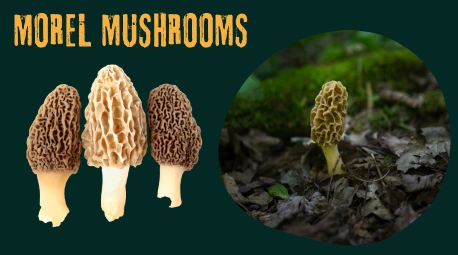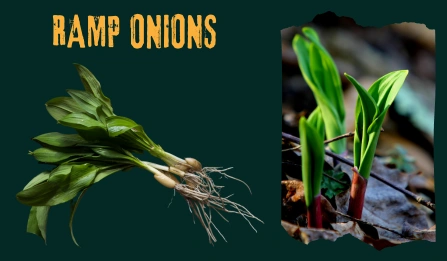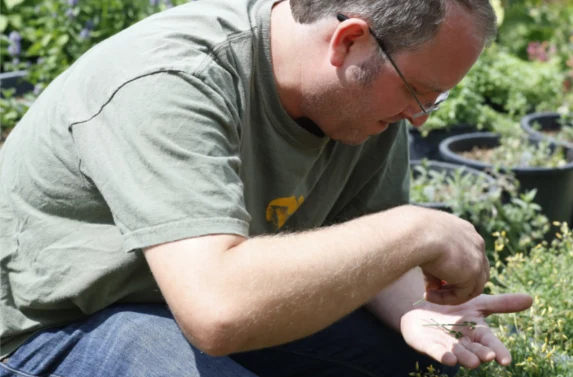Imagine a beautiful forest, a place where plants, animals, and insects live together in harmony. Now picture someone coming into that forest and taking away plants like wild onions called ramps or special mushrooms known as morels. This might not seem like a big deal, but it’s causing some serious problems.
In recent times, more and more people have started picking these plants and mushrooms from the forest. They’re not doing it for fun – they’re doing it to sell them to restaurants in Chicago. This is a kind of stealing called “poaching,” and it’s not just about hunting animals anymore.
Poaching usually means hunting animals illegally, like capturing them when you’re not supposed to. But now, it’s about snatching up plants too. This is happening in places called forest preserves, which are like safe homes for plants and animals. When someone takes away these plants, it can mess up the whole balance of the forest.

Martin Hasler, deputy chief of the Cook County Forest Preserves Police Department, explains, “Some people might think it’s not a big deal, but when we take things away from the forest, it’s like taking away part of its heart.” This is important to remember because the forest is like a home for many living things.
This problem has been around for a while, but it’s getting worse because more people are looking for these plants and mushrooms. They’re using something called social media to show off what they’ve taken from the forest. Other people see these pictures and think it’s cool, so they start doing the same thing.
John McCabe, director of resource management with the Cook County Forest Preserves, says this is a big issue. He’s seen places in the forest where plants have been yanked out of the ground or totally ruined. This hurts the forest and the animals that live there.
The internet isn’t the only problem. People’s growing interest in these plants and mushrooms is making things even worse. These forest preserves are like neighborhoods for plants and animals. Imagine if someone started taking things from your neighborhood – it wouldn’t be nice, right?
So, it’s really important for us to understand that taking plants and mushrooms from the forest is not just a small thing. It can hurt the homes of many creatures and upset the way the forest works. We need to be more careful and think about how our actions can affect the whole ecosystem.

Foraging for Profit Threatens the Forest
While some people gather a few plants for themselves, most foragers are doing it to make money, according to Martin Hasler, who helps take care of the forest preserves. “There’s a market for this,” Hasler explained. These foragers know where to find these plants, what to look for, and where to sell them.
Foraging can be done in a way that doesn’t harm the forest, but sadly, many foragers are causing damage. They collect huge amounts of plants, sometimes filling up bags, just to sell them. John McCabe, who works with the forest preserves, said that restaurants like to use locally grown foods. But here’s the problem: some of the plants they’re using are actually taken from the forest preserves illegally.
McCabe warned that even though there might be a lot of these plants right now, if too many people keep taking them, they could disappear really quickly. Think about it – if too many people start picking these plants, there might not be enough left for the animals and the forest itself.
Dave Odd, a professional forager who has been collecting and selling wild foods for years, knows about this issue. He used to supply plants to restaurants, but he had a hard time because the demand changed a lot. “Sometimes I’d sell a lot, and other times, I’d sell nothing,” Odd said.

Odd would find plants in all sorts of places around the city, like along the sides of roads or in alleys. He admitted that sometimes he took plants from places he shouldn’t have.
“Everybody who loves foraging has taken something from a spot they shouldn’t have,” Odd shared.
During his busiest time, Odd worked with about 40 businesses each week. He would give chefs special plants to use in their dishes. Ramps, a type of wild onion, were really popular. But there’s a problem with this popularity – if too many ramps are taken, it could hurt the forest.
Imagine if everyone started picking all the apples from the apple trees in your neighborhood. There wouldn’t be any apples left for you, right? It’s kind of like that with these plants. We have to be careful not to take too many, or else the forest won’t be a healthy home for plants and animals anymore.
There Is A Right Way To Forage!
Chicago’s name actually comes from a Native American word, “chicagoua,” which refers to a strong-smelling plant like an onion or garlic. This plant is believed to be the same one as the ramp, a wild onion that grows in the area.
Kevin Erickson, who works at Loyola University, loves foraging – that’s when people gather plants and mushrooms from the wild to eat. But he knows that doing it in the right way is super important. “If everyone wanted to do that, it’d be gone,” Erickson warned.
So, what’s the right way? Well, it’s all about being sustainable. That means not taking too much so that the plants can keep growing. You see, some foragers pick way too many plants, and that can be bad for the forest.
Erickson has some rules for sustainable foraging.
First, don’t pick young plants that haven’t had a chance to grow.
Second, leave at least 25% of the plant or patch behind. This lets the plants keep living and growing. And guess what? They can come back in just a few days!
But catching plant poachers isn’t easy. When someone sees a poacher taking plants, they can call the forest preserve police. But a lot of times, the poacher runs away before the police can get there.
More To Discover
- UK Launches Investigation into Dove Parent Unilever’s Green Claims
- Grain Husk Packaging: The Future Alternative to Plastic Styrofoam in Your Next Delivery
- Transparency Gap: Companies Fail to Report Impact of Environmental Initiatives
- Bottled Water Industry Responds to Columbia University Study on Nanoplastics & They’re Not Wrong
Even if a poacher gets caught, the plants they took usually can’t be put back. Some poachers are sneaky, parking far away and hiding their bags from other people who use the forest.
Poachers can get fined if they’re caught – that means they have to pay money as a punishment. But with millions of people visiting the forest every year, the staff says it’s not realistic to have a system where people need permission to forage.
The police who work in the forest have a hard job. They try to catch poachers, but it’s not always easy. John McCabe, who works there, said it’s tough to know exactly how many poachers there are.
Most people do the right thing, according to McCabe. They know they shouldn’t take too much from the forest.
If you’re a forager, it’s important to follow the rules. That way, we can all enjoy the wild plants for a long time. Erickson thinks being in nature is important, whether you’re picking plants or not. “We want to value them and not just think of them as resources for food,” he said.



















